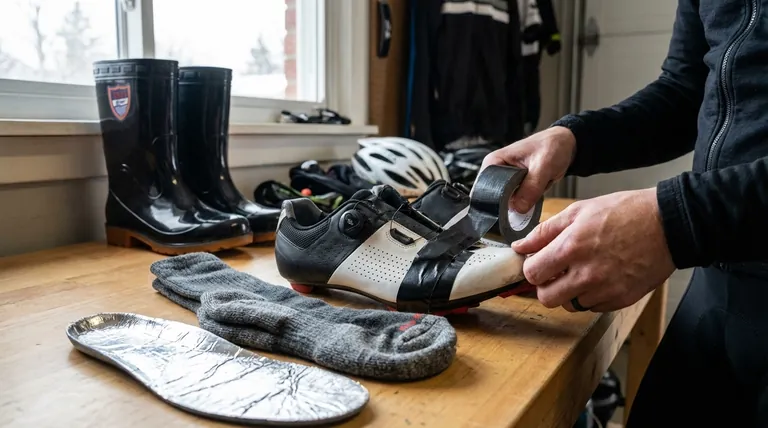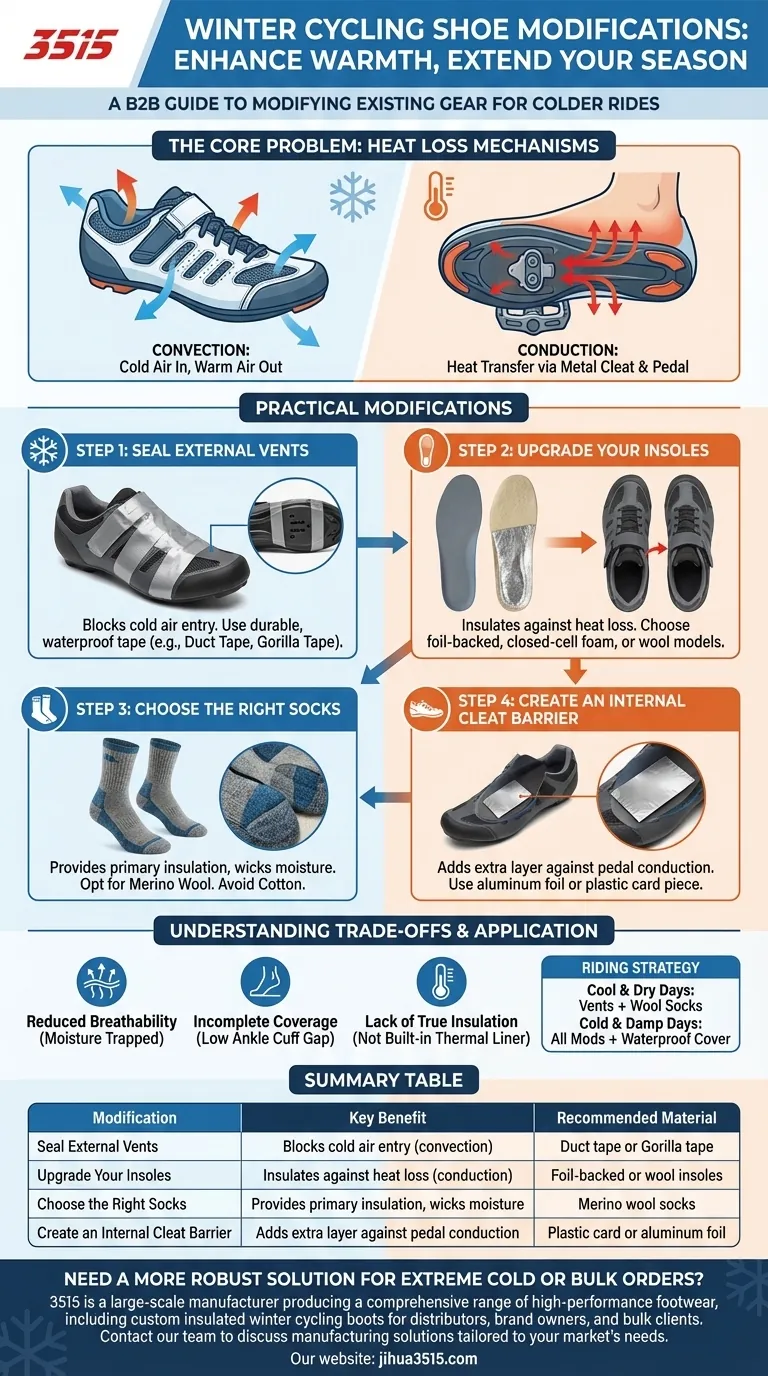The most effective way to make your existing cycling shoes warmer is by systematically blocking cold air entry and adding insulation. This involves covering external ventilation holes with a material like duct tape and upgrading internal components like your socks and insoles to better retain heat.
Your summer cycling shoes are engineered to cool your feet by maximizing airflow. To prepare them for winter, you must reverse this design by sealing air leaks and insulating against heat loss through the sole.

The Core Problem: How Your Feet Lose Heat
Your standard cycling shoes become liabilities in the cold due to two primary forms of heat transfer. Understanding them is key to effectively modifying your gear.
The Role of Convection
Your shoes are full of ventilation holes designed to pull in cool air and exhaust hot, moist air. This process, known as convection, is excellent for summer but allows frigid winter air to constantly strip heat from your feet.
The Impact of Conduction
Your cleats and pedals, typically made of metal, are highly effective at conducting heat. They act as a thermal bridge, pulling warmth directly from the sole of your foot in a process called conduction.
Practical Modifications for Your Existing Shoes
You can counteract these effects with a few simple, low-cost adjustments that target airflow and insulation.
Seal External Vents
The first step is to stop cold air from getting in. Place a layer of durable, waterproof tape, like duct tape or gorilla tape, over all the mesh panels and ventilation holes on the top and sides of your shoes.
You can also apply tape to the vent holes on the bottom of the sole for a more complete seal.
Upgrade Your Insoles
The stock insole in your shoe offers minimal insulation. Replace it with a thermal model, such as one with a foil backing or one made from closed-cell foam or wool.
This new layer creates a critical barrier, slowing down heat loss through the conductive metal cleat and pedal system.
Choose the Right Socks
Socks are your primary insulation layer. Avoid cotton, which holds moisture and makes your feet colder when they sweat.
Opt for socks made from merino wool. It is an exceptional insulator, retains warmth even when damp, and effectively wicks moisture away from your skin.
Create an Internal Cleat Barrier
For an extra layer of protection against conduction, you can place a small, thin barrier inside your shoe, underneath the insole.
Position this barrier directly over the cleat mounting area. A piece cut from an old plastic credit card or a folded piece of aluminum foil can work to further isolate your foot from the pedal.
Understanding the Trade-offs
These modifications are effective, but they are not a perfect substitute for dedicated winter cycling shoes. It's important to recognize their limitations.
Reduced Breathability
Sealing the vents with tape traps air, which is great for warmth, but it also traps moisture. On longer or more intense rides, your feet may become damp with sweat, which can eventually lead to feeling cold.
Incomplete Coverage
Standard cycling shoes have a low ankle cuff. This design leaves a gap where cold air and moisture can enter between your shoe and your tights, a problem that purpose-built winter boots solve with a higher, sealed cuff.
Lack of True Insulation
While these tricks add warmth, they don't replicate the built-in thermal liners and fleece found in winter-specific shoes. In truly frigid or wet conditions, their effectiveness will diminish significantly.
How to Apply This to Your Rides
Your strategy should depend on the conditions you plan to face.
- If your primary focus is riding on cool, dry days: Sealing the vents and wearing merino wool socks is an excellent and sufficient solution.
- If your primary focus is riding in colder, potentially damp conditions: Combine all modifications—taping vents, adding thermal insoles, and wearing wool socks—and consider using a waterproof shoe cover for complete protection.
By systematically sealing your shoes from the outside and insulating them from the inside, you can extend your riding season without a major investment.
Summary Table:
| Modification | Key Benefit | Recommended Material |
|---|---|---|
| Seal External Vents | Blocks cold air entry (convection) | Duct tape or Gorilla tape |
| Upgrade Your Insoles | Insulates against heat loss (conduction) | Foil-backed or wool insoles |
| Choose the Right Socks | Provides primary insulation, wicks moisture | Merino wool socks |
| Create an Internal Cleat Barrier | Adds extra layer against pedal conduction | Plastic card or aluminum foil |
Need a more robust solution for extreme cold or bulk orders? As a large-scale manufacturer, 3515 produces a comprehensive range of high-performance footwear, including insulated winter cycling boots, for distributors, brand owners, and bulk clients. Our production capabilities encompass all types of shoes and boots, ensuring durability and thermal efficiency for any condition. Contact our team today to discuss custom manufacturing solutions tailored to your market's needs.
Visual Guide

Related Products
- Durable Waterproof Rain Boots | Custom Manufacturer for Wholesale & Brands
- Premium Suede Sport Safety Shoes for Wholesale & Bulk Orders
- Safety Footwear Wholesale Manufacturer for Custom OEM/ODM Production
- Wholesale Training Shoes with Dial Lacing System Custom OEM Manufacturing
- Durable Rubber Sole Outdoor Shoes Wholesale & Custom Manufacturing
People Also Ask
- What certifications should you look for when purchasing sustainable Wellington boots? Choose GRS and FSC for verified eco-friendly footwear.
- What are the risks of having wet feet in cold conditions? Protect Against Hypothermia & Injury
- Are wellies harmful to toddlers' feet? A Guide to Safe & Healthy Footwear
- Why are wellies particularly useful for toddlers? Unlock the Key to Messy Play & Development
- How do wellies benefit both toddlers and parents? Unlock Messy Play & Peace of Mind



















